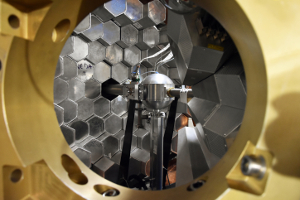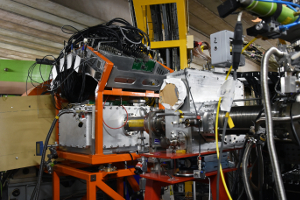GANIL (Grand accélérateur national d'ions lourds) is carrying out its 2018 experimental campaign from April to July. During the four months of operation, experiments in nuclear physics, atomic physics and materials science will be conducted by research teams from all around the world. Industrial users will also be welcomed at GANIL.
During this period, the GANIL accelerators will operate 24 hours a day, 7 days a week. Technical and scientific staff take turns in the laboratory to set up the beam and ensure that the experiments run smoothly. They offer research teams the best conditions for their work.
Programmed nuclear physics experiments
This year, the AGATA spectrometer (Advanced GAmma Tracking Array) is used in five experiments scheduled from April to July at GANIL. Equipped with 35 detection capsules, it is coupled for the first time to the NEDA neutron detectors (Neutron Detector Array) and the DIAMANT charged particle sensor. This detection set is unique in identifying very exotic nuclei produced during the fusion of two heavy nuclei. The common point of the experiments planned for 2018 with this device is the study of the structure of the nucleus, questioning the relationships between protons and the neutrons that compose it.
Researchers are particularly interested in nuclei with the same number of protons and neutrons (N=Z). Their study reveals some nuclear interactions components, such as proton-neutron pairing. It aims to describe how nucleons couple in pairs to create the structure of the nucleus. During this campaign, the phenomenon was explored through the study of the Ruthenium-88 nucleus (44 protons, 44 neutrons).
Two experiments aim to collect information on the independence of nuclear interaction from the nature of the nucleon (proton or neutron), called isospin symmetry. Researchers will study the excited states of "mirror" nuclei (same number of nucleons with an inverted number of protons and neutrons) as between Galium-63 and Germanium-63 or between Krypton-71 and Bromo-71.
One of the experiments focuses on nuclei close to Tin-100, a doubly magical nucleus (50 neutrons and 50 protons) that is unknown because it is difficult to create in the laboratory. By identifying the excited states of more easily achievable closed nuclei such as Tin-102 and 103, researchers hope to recover additional data to learn more about the degree of "magic" of Tin-100.
Finally, one of the research teams is interested in the shape of the Xenon-112 nucleus. Its particularity is to be pear-shaped and therefore having an asymmetry on one of its axes. The measurement of the degree of deformation in relation to the sphere could confirm the hypothesis of a novel coupling of proton-neutron within this nucleus.
The ACTAR TPC active target and CATS beam trackers were used in an experiment in May. The CIME cyclotron was unable to provide the initially planned Fluor-17 radioactive beam. Nevertheless, it delivered a Neon-20 beam that was used to further demonstrate the proper functioning of ACTAR TPC for resonant diffusion reactions, allowing the excited states of the Neon-20 to be probed.
Three experiments are planned with the LISE spectrometer during the 2018 campaign.
For these three experiments, a set of charged particle detectors, MUST2, is used to study the nuclear structure and decay modes of radioactive nuclei so unstable that they will only exist for the time of their synthesis. The challenge is to understand how nuclear forces structure atomic nuclei with a (very) large excess of protons compared to the number of neutrons they contain.
For the first experiment, the experimental set-up consisted of 5 MUST2 telescopes able to detect charged particles, an EXL multi-detector composed of cesium iodide scintillators (CSI) and an LABR3 detector able to detect gamma rays. This experiment used an Oxygen-14 radioactive beam , produced by SPIRAL1 facility, and a polypropylene target (CH2) to populate and study the excited states of Fluor-15 and their decay modes (proton, 2-protons or gamma). This could impact our understanding of stellar explosions called "X-ray bursts".
In a second experiment, the unbound nuclei of Carbon-7 (6 protons and 1 neutron) and Boron-6 (5 protons and 1 neutron) were produced in two steps. One, the radioactive nuclei of Carbon-9 and Boron-8 were selected with LISE in the fission of stable nuclei of Carbon-12 delivered at high energy by the CSS1 and CSS2 cyclotrons of GANIL. Then after their creation, they lost two additional neutrons by interacting with a solid hydrogen target. The particles emitted in their instantaneous decay are detected with MUST2, in particular the emission of an aggregate of 4 protons.
In the last experiment, Calcium-34 (20 protons and 14 neutrons) nuclei was studied according to the same principle. Two neutrons were removed from a Calcium-36 radioactive nuclei by interacting with the hydrogen target. This experiment aims to determine if Calcium-34 nucleus decays by emitting 2 protons, an extremely rare radioactivity mode.
During the analysis of the data, the properties of the formed nuclei will be compared with those of their mirror nuclei rich in neutrons, i.e. having a symmetrical number of protons and neutrons. The properties of Calcium-34 will be compared, for example, to the famous bubble nuclei studied in the past in GANIL: Silicon-34 (14 protons and 20 neutrons). Carbon-7 will be compared in the same way to Hydrogen-7 (1 proton and 6 neutrons) discovered in GANIL 10 years ago with the MAYA detector, and for which decay into an aggregate of 4 neutrons is currently being sought in Japan.
These three experiments involve researchers from several French and foreign laboratories, including a team from the Japanese Riken facility, which is lending us the CRYPTA hydrogen target using liquid helium to solidify the hydrogen. With the use of MUST2, the teams mobilized around LISE in 2018 will have to face several technological as well as scientific challenges.
Contact: Myriam Grar (Ganil)






